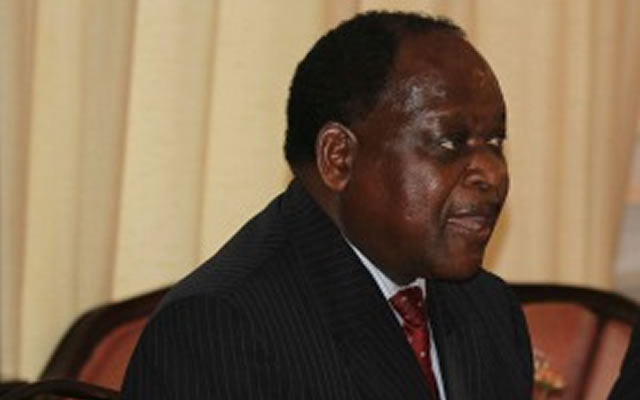Govt launches monitoring policy

Happiness Zengeni Business Editor
GOVERNMENT has launched the National Monitoring and Evaluation Policy to facilitate effective implementation of its medium-term economic blue blueprint, Zim-Asset, with all key public officials set to be trained in this regard.
The policy is anchored on an integrated results-based management methodology, Chief Secretary to the President and Cabinet Dr Misheck Sibanda said during the official launch at Pandhari Hotel yesterday.
This comes after the realisation that the biggest challenge facing Government is the lack of sustainable implementation of its policies since independence in 1980.
Policies implemented since 1980 include Growth with Equity (1981), the Transitional Development Plan in 1982 and the five-year National Development Plan in 1986. The second year of the five-year National Development Plan was abandoned in favour of the Economic Structural Adjustment Programme (ESAP) in 1991.
After that there was Zimbabwe Programme for Economic and Social Transformation (Zimprest) in 1996, Vision 2020 in 1999 after the devaluation of the Zimbabwe dollar in November 1997, the Millennium Economic Recovery Programme (MERP) in 2000 among others
“The weakest link in the implementation of policies, programmes and projects has been absence of a national monitoring and evaluation policy to give guidance and credence to the achievements of results through correct diagnosis,” according to the policy document.
It is believed that the achievements, that brought socio-economic transformation, growth and development, could have been up-scaled on a more sustainable way if Government operations were guided by a results-based framework.
According to analysts, the problem which Government has been facing is the failure in linking up the vision with the reality on the ground.
The policy notes that a Results-Based Management System was introduced in 2005 but it failed because of a weak value chain that includes the absence of a Results-Based Integrated Development Plan, non-implementation of the Results-Based Budgeting and the absence of a Results-Based Monitoring and Evaluation Policy to guide the policies.
The policy dovetails into the objectives of the elaborate Government-private sector architecture driving the implementation of the Zim-Asset Policy.
Public officials, namely ministers, permanent secretaries, Government planners, implementers, State enterprises, parastatals, private sector, institutions of higher learning, civil society and development partners will receive training.
To that end, all Zim-Asset clusters, ministries and departments, State enterprises and parastatals will be required to develop and submit to the Office of the President and Cabinet their monitoring and evaluation strategies.
Dr Sibanda said they will be compelled to implement and continuously review the strategies in line with the developments in the policy environment.
The requirement will also apply to all public sector institutions, civil society and private organisation that are registered with Government and handle public funds.
“It is worth noting that Monitoring and Evaluation is essentially a management tool to foster the improvement and attainment of results,” Dr Sibanda said.
“May I point out that the application of monitoring and evaluation is like holding a mirror to ourselves, to see how well we are performing in the implementation of policies, projects and programmes in our areas of responsibility.”
He said monitoring helps to keep the implementation of policies, projects and programmes on track and assists in determining if allocated resources are sufficient and weather the resources are being utilised in an efficient way.
The objectives of the policy include facilitating assessment of relevance, effectiveness, efficiency, impact and sustainability of specific programmes or projects.
It will establish how well institutions are performing, in relation to targets and performance indicators, assist in early identification of challenges and remedial action as well as generate insights to for proper planning and remodelling.
Further, the policy objective will be “fostering greater transparency, accountability and professional management of scarce public resources and guaranteeing of quality service delivery, Dr Sibanda told delegates at the launch.
Dr Sibanda said the policy was crafted by the rapid results inter-ministerial team under the leadership of the Office of the President and Cabinet.
The policy was also drafted with technical assistance from the African Community of Practice Country Coaches and financial support of World Bank and African Development Bank and input from among individual and corporates.
“This comes at a time when we are currently working to transform Zimbabwe’s economic fortunes through the accelerated implementation of Zim-Asset,” he said.
Dr Sibanda pointed out that governments throughout the world are increasingly under pressure than ever before to achieve more using limited resources.
He said governments also facing growing public demand to account for results and this compelled efficient and effective implementation of programmes.
Dr Sibanda said by its nature, the monitoring and evaluation process provides a platform for responsiveness to the demand of cross-cutting issues.
These include gender, environmental sustainability, indigenisation, disability, governance, poverty eradication, partnerships, rural development, disaster preparedness, employment creation, human capital development, information communications technology and HIV and AIDS among others.
Market analyst Evonia Muzondo welcomed the policy saying it was a step in the right direction for the economy as it provides the much needed guidelines in policy implementation. “In as much as Government puts forward clearly defined policies; the lack of proper guidelines for attaining economic growth, macroeconomic dislocations, lack of continuity coupled with traces of political deception and rampant looting, then all those blue prints will always gather dust on government shelves. However with the coming in of the Monitoring and Evaluation Programmes, there will be greater accountability,” she said.











Comments